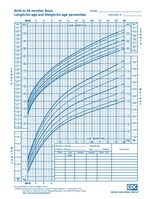
Photo from wikipedia
OBJECTIVE To evaluate change in the incidence of FTT based on selected growth percentile criteria and diagnostic codes before and after a switch in growth curves. METHODS We performed a… Click to show full abstract
OBJECTIVE To evaluate change in the incidence of FTT based on selected growth percentile criteria and diagnostic codes before and after a switch in growth curves. METHODS We performed a retrospective cohort study of children 2 to 24 months of age in a large primary care network that switched its default growth curve from the Centers for Disease Control (CDC) reference to the World Health Organization (WHO) standards in 2012. We compared the incidence of FTT defined by growth percentile criteria (using the default growth curve at the time of each measurement) and by ICD-9 codes in the three years before and after the CDC-WHO switch using an interrupted time series analysis. We performed these analyses stratified by age group (≤6 months and >6-24 months). RESULTS We evaluated 83,299 children. Among those ≤6 months, increases in FTT incidence were found in both growth-percentile and clinician-diagnosis criteria at the CDC-WHO switch (p<0.05). Among those >6-24 months, decreases in FTT incidence were found by growth-percentile criteria at the CDC-WHO switch (p<0.05), but no significant changes were found in FTT incidence by diagnostic codes. CONCLUSIONS When switching from the CDC to the WHO growth curves, changes in the incidence of FTT by growth-percentile and clinician-diagnosis criteria differed for younger versus older infants. Factors beyond growth likely influence the decision to diagnose a child as having FTT and may differ in younger compared to older infants.
Journal Title: Academic pediatrics
Year Published: 2019
Link to full text (if available)
Share on Social Media: Sign Up to like & get
recommendations!